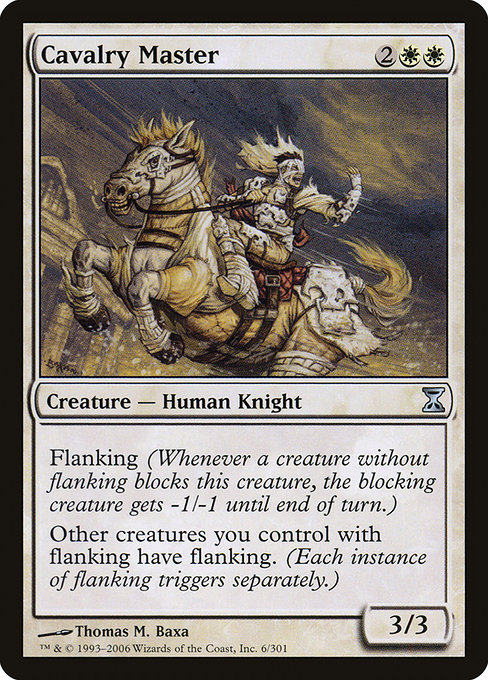
Image courtesy of Scryfall.com
Humor as a Lens on MTG Complexity
Magic: The Gathering has always thrived on depth—complexity drawn from elegant rules, intricate interactions, and the ever-shifting meta. Some of the sharpest humor about the game comes from leaning into that complexity, then poking fun at how easily a single card can ripple into a dozen edge-case scenarios. It’s not cynicism; it’s a shared language among players who’ve spent hours untangling combat steps, triggers, and layer after layer of decisions. 🧙♂️🔥💎 In that playful spirit, Cavalry Master from Time Spiral becomes a surprisingly effective mirror. It looks like a straightforward White creature at first glance, then invites you to peel back the rules-layered onion and savor the strategy—while winkingly acknowledging the game’s glorious tangle of rules. 🎨⚔️
Meet the Knight: Cavalry Master and the Flanking Frontier
From Time Spiral, Cavalry Master is a white, uncommon Human Knight with a stat line of 3 power / 3 toughness for a mana cost of 2 generic and 2 white (total CMC 4). Its ability is built around the now-classic keyword Flanking — the kind of mechanic that both rewards aggressive design and invites witty “what if” moments at the table. The oracle text reads: Flanking (Whenever a creature without flanking blocks this creature, the blocking creature gets -1/-1 until end of turn.) Other creatures you control with flanking have flanking. (Each instance of flanking triggers separately.) This means Cavalry Master not only hits hard, but also drags your entire white cavalry into a layered dance of minus-one-minus-ones and trigger audibles. It’s a microcosm of MTG’s tactical depth, where one line of rules can cascade into multiple decisions on every combat step. 🧙♂️⚔️
“Sometimes the simplest knights reveal the deepest mechanics.”
That stray line of text—multiple instances of flanking, and the way Cavalry Master can cause a chorus of simultaneous flanks when you bring along other flanking creatures—becomes a playful critique of how a single keyword can broaden the battlefield in unexpected ways. It’s a reminder that complexity in MTG isn’t just in numbers; it’s in relationships, layering, and how a table handles a swarm of triggers that can feel almost ritualistic in their cadence. 🔥🎲
Humor as Critique: Why Card Humor Resonates with Strategy
Humor cards and humorous takes on MTG complexity work because they validate what many players secretly think: the game rewards patience, careful parsing, and a sense of whimsy about the chaos of interaction. Cavalry Master, with its elegant but dense flavor around flanking, offers a tongue-in-cheek blueprint for that idea. It’s not just about being a powerful creature; it’s about being a public relations parade for complexity—making the rules feel grand, cinematic, and just a little ridiculous in the best possible way. 🧙♂️💎
Strategic Takeaways: How to wield Cavalry Master in a Deck
- Board presence with bite: At 4 mana for a 3/3, Cavalry Master isn’t a tempo bomb, but paired with other forces, it helps you push through while applying pressure that your opponent must answer. The flanking ability adds value in midrange alignments where you want multiple blocking-creature choices to suffer the -1/-1 cascade. ⚔️
- Terrain for flanking synergy: The line “Other creatures you control with flanking have flanking” means you can assemble a small cadre of white knights and extend the chain of flanking effects. If you’ve built a board with two or more flanking threats, trades and combat damage become a test of patience and calculation—precisely the kind of mischief humor cards love to highlight. 🧩
- Deck archetypes: Cavalry Master fits neatly into classic White Weenie/midrange shells or any build that tilts toward creature-on-creature combat. It shines in formats where your opponent’s blockers are multiple and you can leverage the cascading triggers to swing the balance at each combat step.
- Rule-reading resilience: The card’s text is a gentle reminder to players that even “simple” combat can branch into layered rulings. The flavor of the era—Time Spiral’s nod to mischief, time-warped design, and a cavalier sense of absurdity—pairs well with a player’s own joy in decoding interactions. 🧭
Art, Set, and Value: A Snapshot of Flavor and History
Thomas M. Baxa’s art for Cavalry Master captures a poised, steel-clad knight ready to swing at a moment’s notice. The Time Spiral set, released in 2006, is known for revisiting classic mechanics with modern twists, a playful acknowledgment that Magic’s complexity can be both a challenge and a treasure hunt. The card itself is an uncommon—foil and non-foil finishes exist—and it carries a modest market footprint today. The provided data shows a current price around $0.09 USD for non-foil and about $0.35 for foil, with the typical spread you’d expect for an older uncommon. Not glamorous in the way chase mythics are, but perfect for the “hidden gem” shelf of any white-centered collection. A tiny treasure chest for fans who love that retro-sigil of strategy-as-story. 💎
For collectors who savor the tactile and visual side of MTG, Cavalry Master embodies a particular moment in the game’s design history: a time when the line between straightforward knightly bravado and intricate battlefield math could be walked with a wink and a grin. The packaging, the art, and the block of rules that surround flanking all contribute to a sense of nostalgia that’s as vibrant as ever when you pull the card from a pack or flip it up in a casual duel. 🎨🧙♂️
Custom Gaming Mouse Pad 9x7in Neoprene Stitch EdgesMore from our network
- https://crypto-acolytes.xyz/blog/post/why-crypto-matters-for-censorship-resistance/
- https://blog.digital-vault.xyz/blog/post/blue-hot-star-reveals-mass-flame-and-stellar-mass-estimation-challenges/
- https://blog.digital-vault.xyz/blog/post/a-cosmos-charger-card-art-reprints-visual-showdown/
- https://blog.digital-vault.xyz/blog/post/visualizing-tatsunari-toad-riders-set-level-rarity-trends/
- https://blog.rusty-articles.xyz/blog/post/five-parameter-astrometric-solution-reveals-lupus-blue-giant/